calsfoundation@cals.org
Vapors
The Vapors was a nightclub in Hot Springs (Garland County) during the last era of illegal gambling in the city. Upscale entertainment in the style of Las Vegas, Nevada—featuring well-known acts like Edgar Bergen, the Smothers Brothers, and Tony Bennett—distinguished it from many of the rival clubs in the area.
Dane Harris, who had been a World War II pilot, accumulated money from a stake he had in the Belvedere Country Club and casino during the 1950s and used that money to build the Vapors nightclub. Harris partnered with Owen Vincent “Owney” Madden, owner of the Cotton Club in New York and a noted gangster, to build the nightclub at a site at 315 Park Avenue formerly occupied by the Phillips Drive-In. The club was built in the summer of 1959 and opened in 1960, offering the Vapors’ Coffee Shop; the Monte Carlo Room for meetings, events, and luncheons; a large lobby; a dance floor; a theater restaurant with tiered seating and a retractable stage big enough for an orchestra; and a casino that opened late in the evening. Entertainment included two shows every night featuring some of the most popular entertainers in the country.
Tony Bennett noted in his autobiography that he first sang his signature hit “I Left My Heart in San Francisco” at the Vapors. While rehearsing the song there for a later appearance at the Fairmont Hotel in San Francisco, California, Bennett sang the song through once and was told by the only audience member, a bartender setting up for the evening, “If you guys record that song, I’ll buy the first copy.”
In the late morning of January 4, 1963, an explosion rocked the Vapors, causing extensive damage. Twelve injuries were reported, and three people required hospitalization. Speculation about who was responsible ranged from outside crime syndicates attempting a takeover to local small club owners lashing out in response to raids against their own facilities. Such raids were intended to take the public pressure off authorities while leaving more prominent clubs like the Vapors alone. As a result of the bombing, a wall separating the casino from the lobby was demolished, exposing the club’s gaming tables and slot machines to the street. Reporters covering the bombing for the Arkansas Gazette managed to snap a photograph of the slot machines and craps tables against the orders of police officers securing the area. The photo appeared on the front page of the next day’s edition, providing clear proof of illegal gambling in Hot Springs, but illegal gambling would not be completely curtailed in the city until 1967, six months into the first term of reformist Governor Winthrop Rockefeller.
Unlike many former casinos in Hot Springs, the Vapors continued to operate as a nightclub and restaurant after its casino was closed. In 1977, responding to changing tastes in entertainment, Dane Harris began renovations to the club, which would see the addition of the Cockeyed Cowboy and Apollo Disco, as well as an additional showroom completed in 1980.
Harris died in 1981. The Vapors continued to operate as a nightclub into the 1990s but only as a lackluster shadow of its former self. The building was sold in October 1998 to Tower of Strength Ministries for use as a church; in November 2013, the building was again put up for sale.
For additional information:
Allbritton, Orval E. Leo and Verne: The Spa’s Heyday. Hot Springs, AR: Garland County Historical Society, 2003.
Bennett, Tony. The Good Life. New York: Pocket Books, 1998.
Brown, Dee. The American Spa: Hot Springs, Arkansas. Little Rock: Rose Publishing Company, 1982.
“Dane Harris Dies at 62; Rose to Prominence in Hot Springs Heydays.” Arkansas Gazette, June 11, 1981, p. 2A.
Davis, Lynn A. They Said It Couldn’t Be Done: Closing Down the Biggest Illegal Casino Operation in America, Hot Springs, Arkansas, 1967, in 120 Days. Little Rock: Days Creek Press, 2009.
Hill, David. The Vapors: A Southern Family, the New York Mob, and the Rise and Fall of Hot Springs, America’s Forgotten Capital of Vice. New York: Farrar, Straus and Giroux, 2020.
“Home-Owned? ‘No,’ Chicago Official Says of Hot Springs Clubs.” Arkansas Gazette, January 8, 1963, pp. 1, 8A.
Ramsey, Patsy Hawthorn. “A Place at the Table: Hot Springs and the G.I. Revolt.” Arkansas Historical Quarterly 59 (Winter 2000): 407–428.
Scully, Francis J. Hot Springs, Arkansas and Hot Springs National Park: The Story of a City and the Nation’s Health Resort. Little Rock, AR: Hanson Co., 1966.
Shaw, Robert. “Mysterious Blast Rips Vapors Club; At Least 12 Hurt.” Arkansas Gazette, January 5, 1963, p. 1A.
Weatherly, Jack. “Historic Spa City Club Returns to Sales Block.” Arkansas Democrat-Gazette, February 23, 2014, pp. 1G, 7G.
Michael Hodge
North Little Rock, Arkansas

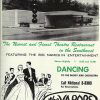

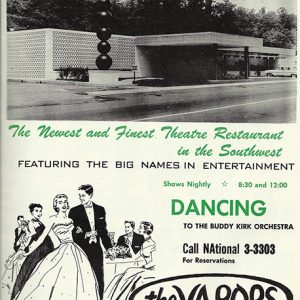 Vapors Ad
Vapors Ad 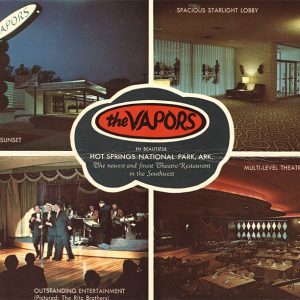 Vapors Postcard
Vapors Postcard 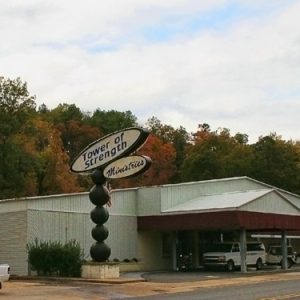 Vapors, Former Location
Vapors, Former Location 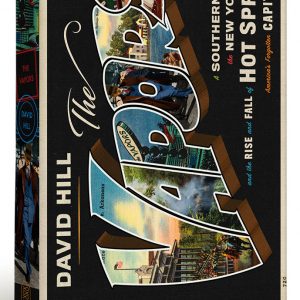 The Vapors
The Vapors 



I have this very post card. It was autographed by a man that looks to be Ray Tueshay or Tuesday in 1969 to my mother Charlotte, who I think was a waitress there. My mother just recently passed and finding gems like this postcard shows me the the amazing memories she had in her lifetime.
I appreciate that this article is correct when it talks about the Vapors being a classy club with Vegas-style entertainment. My former husband was the general manager of the Vapors in 1969 and 1970. I spent a few enjoyable evenings there. I dined in the three restaurants and was entertained in the huge area where the stage had wonderful stars gracing it. I remember meeting one of the Ames Brothers. My daughter, Gina, was an infant, and Mr. Ames was playing with her. I grabbed her as she was reaching for his hair, just in time. Otherwise, she could have possibly pulled the toupee off of Mr. Ames’s head! My former husband’s name was Don Chotikasilpa. He was a great manager and a fantastic chef.